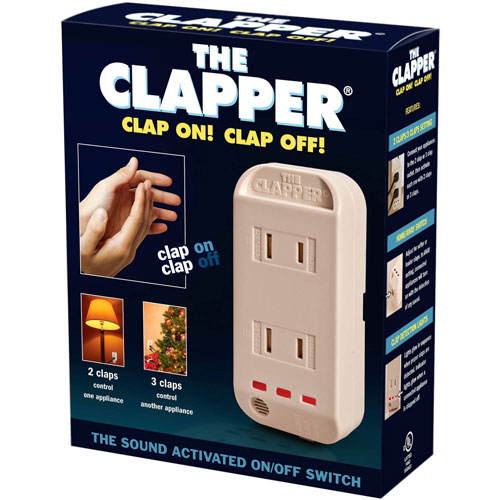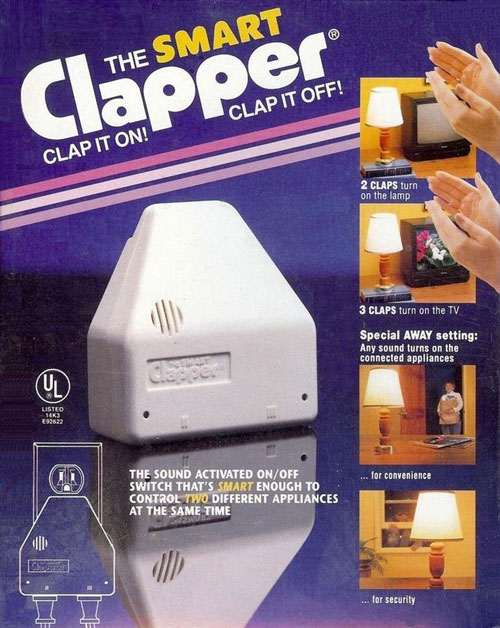Please Clap
The tale of The Clapper, a device that introduced millions of people to the idea of simple home automation. Would we have Alexa without it?
1975
The year that Pico Electronics, a Scottish manufacturer, came up with the X10 home automation standard, which used data through pushed power lines to communicate different functions. (The company didn’t launch around home automation, but stumbled into it after manufacturing calculators and record systems.) The system, while the dominant one of its era and still used today, was still somewhat obscure and used a series of remote switches to do its thing. It worked but it was fairly complicated, and was not initially wireless. In case you’re curious what it’s like, Lazy Game Reviews did a great video on an IBM-compatible X10 system, dating to the 1980s, last year.

The current design of The Clapper.
Why The Clapper was still an important invention for home automation, even if it wasn’t first
The X10 system eventually became well-known among weekend warriors, but didn’t become particularly popular until the 1990s, and I can find little evidence of it even being mentioned in mainstream media outlets before 1986.
And the name X10, for many, may not even evoke home automation systems—instead, there’s a good chance it’ll make people think of webcams, thanks to a company called X10, a direct descendant of the original firm, using the name to heavily promote webcams online during the late ’90s. The company even gained an air of infamy, due to its aggressive, ineffective use of pop-under banner ads. (Really.)

The X10 website, circa 2004.
Geek.com’s Rob Hughes spoke for the internet when he asked, “Who is X10 targeting with these campaigns?”
Anyway, back to home automation. So if The Clapper wasn’t first to the home automation trend—only showing up during the late 1980s—why should we care?
A good reason for that, I would argue, comes down to a combination of promotion and disposability. The X10 system was very complex and not a good fit for every home—which is probably why the company was trying to sell webcams instead of automation systems to the mainstream consumer.
The Clapper, on the other hand, was a device that had a simple function—it turned on an electric current simply because a user made a specific noise—and was marketed in a way everyone understood. It worked well in commercials, too.
If I had to put this into Tedium terms, the X10 system was the Steve Wozniak form of home automation; The Clapper was for everyone else.
The other thing, as well, is that Clapper manufacturer Joseph Enterprises, was an unusual, if effective, corporate steward. Better known for a device called the Chia Pet, the company used television better than perhaps any other company of its era. Its founder, a man named Joseph Pedott, didn’t invent products, but was brilliant at both selling them and manufacturing them—so brilliant, in fact, that his personal papers are housed in the friggin’ National Museum of American History.
As American Express’ Open Forum noted in 2012, Pedott stumbled on the Chia Pet after talking to the head of sales for a drug store chain, later finding out that the owner of the idea was losing money on every sale.
He weeded his way through the supply chain and fixed the problem by cutting out the middle man. (Eventually the company moved the Chia Pet’s manufacturing from Mexico to China.)
He didn’t find the idea for the device’s catchy commercial, however, until he was sitting in a bar somewhere and a friend of his jokingly stuttered the name. Soon, he had a hit commercial and a hit brand—one that even led the company to sell its own brand of chia seeds when the seed earned an unexpected rep as a superfood.
Customize your stuff! Ruin its resale value!
The company sold other products, like the Scribe Ett engraving pen, the Ove Glove kitchen glove, and the Garden Weasel. Pedott, with his rep as a marketing expert, was pitched thousands of devices that he turned down. But it was The Clapper, with its catchy commercials and simple pitch, that broke through in a real way.
And its invention came about with a surprising level of drama, as it turns out.
“Plaintiff, an approximately 80-year-old woman who suffers from arthritis and osteoporosis, claims that she sustained injuries to her hand and wrist when she clapped her hands together in an attempt to activate ‘The Clapper’, a device which is designed to turn electrical appliances on or off by responding to sound.”
— A passage from Hubbs v. Joseph Enterprises, a 1993 appeals court decision based on a lawsuit filed against the owner of The Clapper because a woman clapped her hands and injured herself. The case, coming a year before the infamous “Hot Coffee” lawsuit (which, really, didn’t deserve its infamy), is probably a more deserving example of a dumb court case. It should be noted that the plaintiff in the Clapper case, Edna Hubbs, lost the case.

The Smart Clapper, which has a microchip and works better than the original model.
The Clapper got a brain thanks to a scorned inventor with a great comeback story
Carlile R. Stevens, a serial inventor, was responsible or partially responsible for dozens of inventions over the span of roughly 50 years.
But his most famous invention, The Clapper, came about after his most unfortunate loss. One of his inventions, a an energy-efficient ballast for fluorescent lights, was bought by another company, but the company chose to make its own versions of the device—cutting Stevens and his business partner out of the profits.
It was a humiliating situation, every inventor’s worst fear, though it would eventually have a happy ending. But before the lawyers got involved, Stevens did eventually bounce back with another device: The Smart Clapper.
Stevens’ opening came thanks to the fact that the original Clapper, patented in Canada by Peter Liljequist of Canada and Kou I. Chen of Taiwan in 1985, came out of a desire to create a device that got away from all the remote controls that similar solutions, like the X10 standard, relied upon. But there were a couple of problems: For one thing, it was too sensitive, responding too easily to audio signals and damaging television sets. For another, the inventors tried to screw Joseph Pedott out of the profits. As HowStuffWorks noted, Pedott went up to Canada, battled the men in court, and won.
That’s where Stevens came into the picture, developing a new version of the Clapper that actually properly worked with his coinventor, Dale E. Reamer.
“It was a Crapper, really,” Stevens recalled telling Pedott to The Palm Beach Post in 2011. “I said, ‘Wouldn’t it be nice if you had one that worked? Think how many more you could sell.’”
So that’s what Stevens and Reamer did, developing the Smart Clapper, which first hit the market in 1987 and was patented in 1993.
This move ensured that The Clapper would find its place in pop-culture history, and gave Pedott another device to fortify his legacy.
But in the end, it wouldn’t be Stevens’ biggest victory. That came in 1997, when a court decision involving his florescent light ballast was won in his favor. That decision found that Universal Manufacturing Corporation defrauded Stevens and his business partner, Bill Alling, by purchasing the ballast design to effectively take it off the market.
The court case was long-running, going on for 13 full years, but the victory was particularly financially sweet, because of the nature of the device. Every office building in the world uses fluorescent lights, and the ballasts help steady the electricity so the lights work. By choosing not to use the device, Stevens’ lawyers argued, roughly $100 billion in energy savings was lost.
As a result, Stevens and Alling won a $97 million judgment.
The Clapper was an important device, but it wasn’t worth $97 million dollars, that’s for sure.
“It’s been tough since I put so much money into it,” Stevens told The New York Times.
The great irony? Despite his most lucrative invention being related to fluorescent lights, The Clapper didn’t actually support the compact fluorescent bulbs that later came on the market. It wasn’t the only device that didn’t work; The Clapper, due to changes in electronics, became less useful in the decades after its creation. Our devices got smarter and clapping just wasn’t as effective anymore.
Still though, he had two important, incredibly lucrative inventions to his name. One just happened to be more important than the other.
“The legacy built by Joseph Pedott will always be in the DNA of the company. I am honored to continue his legacy. Thanks to him, more people in America have seen a commercial for the Chia Pet or The Clapper than watched the past nine Super Bowls combined.”
— Joel Weinshanker, the chief operating officer of the National Entertainment Collectibles Association, discussing the company’s acquisition of Joseph Enterprises last month. Joseph Pedott, who operated the company for 55 years and later became a philanthropist, will be involved in the company through its transition. The Chia Pet, despite some questionable diversions, has consistently sold half a million units a year for decades.
Home automation is definitely a bigger trend now than it was 40 years ago. And while X10 and other devices definitely found their audience, it’s arguable that in the age of Alexa, Ring, Wemo, and IFTTT, our home automation approach ended up looking a whole lot more like The Clapper than anything else.
Certainly, The Clapper is not exactly a high water-mark for automation by any means. Its basic technology worked in a very specific context and did not keep up with the times so much.
But its basic marketing approach, the idea that people would want individual devices that did interesting things rather than a highly customizable complex system, essentially played out in the end.
As consumers, we don’t buy home automation technologies because they support Zigbee or Z-wave, though maybe our contractors might. We buy Ring.
The Internet of Things (or as the more cynical among us call it, the Internet of Shit) is less essential in the consumer space than it is the business world. Really, it’s the Internet of Things We Can Buy In Stores.
That’s the market The Clapper invented. That’s the market Ring, Nest, and all of their competitors thrive in.
:format(jpeg)/2018/03/tedium032218.gif)
/2018/03/tedium032218.gif)

/uploads/ernie_crop.jpg)